NCERT Class 5 Maths Chapter 3 How Many Squares?
- BoardCBSE
- TextbookNCERT
- ClassClass 5
- SubjectMaths
- ChapterNCERT Class 5 Maths Chapter 3 How Many Squares?
- Chapter NameChapter 3 How Many Squares?
- CategoryNCERT Solutions
NCERT Solutions Chapter 3 How Many Squares?
NCERT Solutions for Class 5 Maths Chapter 3 How Many Squares? of the NCERT textbook is solved with errorless solutions by experts on Home-tuition.com. Chapter 3 How Many Squares? is fully solved in the below pdf. You can download chapter wise free pdf of Chapter 3 How Many Squares?.
What are you going to learn in Chapter 3 How Many Squares?
How Many Squares?-With the help of this chapter, students learn how to differentiate between the shapes and sizes and how to measure sizes, and recognize which one is bigger or smaller. In the exercises given in this chapter, the students may create new shapes out of a square that does not tile even though their area remains the constant as that of the square they were made from. There are enough activities and exercises to clear all the doubts of the students related to the topic of squares.
With the help of this chapter, students learn how to differentiate between the shapes and sizes and how to measure sizes, and recognize which one is bigger or smaller. In the exercises given in this chapter, the students may create new shapes out of a square that does not tile even though their area remains the constant as that of the square they were made from. There are enough activities and exercises to clear all the doubts of the students related to the topic of squares.
Find below a free pdf of NCERT Solutions for Class 5 Maths Chapter 3 How Many Squares?
Page No 34:
Question 1:
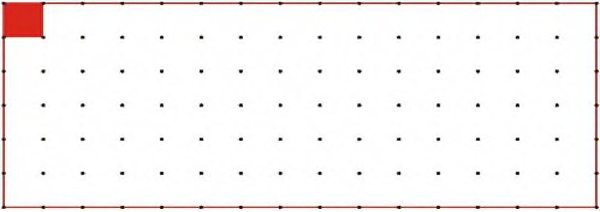
• Measure the side of the red square on the dotted sheet. Draw here as many rectangles as possible using 12 such squares.
• How many rectangles could you make? __________
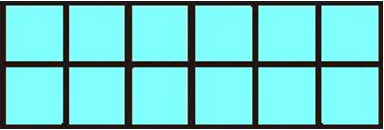
Each rectangle is made out of 12 equal squares, so all have the same area, but the length of the boundary will be different.
• Which of these rectangles has the longest perimeter?
• Which of these rectangles has the smallest perimeter?
Answer:
The length of each side of red square is 1 cm.
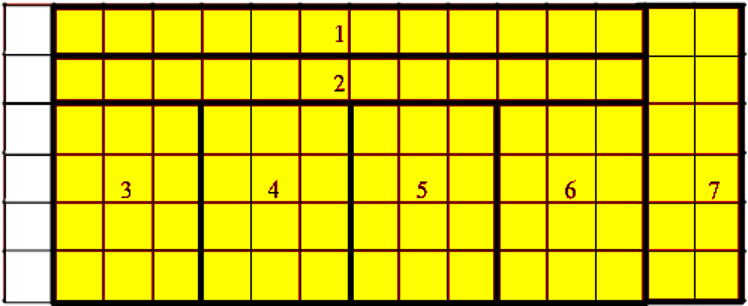
• We can make 7 rectangles as shown in the figure.
• The rectangle 1 and rectangle 2 has the longest perimeter.
• The rectangle 3, rectangle 4, rectangle 5 and rectangle 6 has the smallest perimeter.
Page No 35:
Question 1:
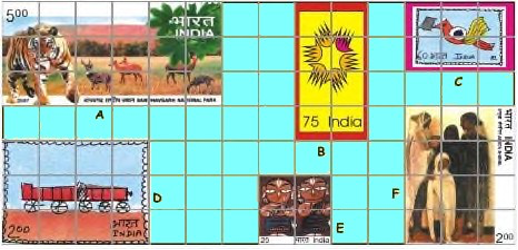
Look at these interesting stamps.
(a) How many squares of one centimetre side does stamp A cover?__________And stamp B? __________
(b) Which stamp has the biggest area? How many squares of side 1 cm does this stamp cover? How much is the area of the biggest stamp? ___________square cm.
(c) Which two stamps have the same area?__________How much is the area of each of these stamps?_____________square cm
(d) The area of the smallest stamp is__________square cm. The difference between the area of the smallest and the biggest stamp is ________square cm.
Answer:
(a) Stamp A covers 18 squares, each of one centimetre side. Stamp B covers 8 squares each of 1 centimetre side.
(b) Stamp A has the biggest area. Stamp A covers 18 squares, each of one centimetre side. Area of biggest stamp = 18 square cm
(c) Stamp D and stamp F has same area. Stamp D and stamp F covers equal number of squares. Each of them covers 12 squares of one centimetre side. Area of each of these stamps = 12 square cm
(d) Stamp E is the smallest stamp. It covers 4 squares, each of one centimetre side. Area of smallest stamp = 4 square cm Now, area of biggest stamp = 18 square cm Difference between the area of smallest stamp and biggest stamp = (18 – 4) square cm = 14 square cm
Page No 36:
Question 1:
(a) Which has the bigger area — one of your footprints or the pages of this book?
(b) Which has the smaller area •two five-rupee notes together or a hundred-rupee note?
(c) Look at a 10 rupee-note. Is its area more than hundred square cm?
(d) Is the area of the blue shape more than the area of the yellow shape? Why?

(e) Is the perimeter of the yellow shape more than the perimeter of the blue shape? Why?
Answer:
(a) The pages of this book has a larger area than the footprint.
(b) A hundred-rupee note has smaller area than two five-rupees notes kept together.
(c) The area of a 10-rupee note is less than 100 square cm.
(d) The yellow and blue shaped figures are divided into 2 triangles of equal areas. We now see that the area of each triangle of the blue shape is more than the area of each triangle of the yellow shape. We can then say, that the area of the blue shape is more than the area of the yellow shape.
(e) With the help of a ruler, we come to find that the length of the boundary of the blue shape is more than the length of the boundary of the yellow shape. Thus, we can say that the perimeter of the blue shape is greater than that of the yellow shape.
Question 2: Trace your hand on the squared sheet on the next page. How will you decide whose hand is bigger • your hand or your friend’s hand? What is the area of your hand?________square cm. What is the area of your friend’s hand?_______square cm.
Answer:
We will trace the hand on the paper and find the area of the paper that gets covered by hand with the help of a square of side 1 cm.
Disclaimer: Students are advised to prepare the answer on their own.
Page No 40:
Question 1: Write the area (in square cm) of the shapes below.

Answer:
We will ignore a square if it is less than half-filled but we will count the square as 1, if it is more than half-filled.
Figure A covers three squares that are more than half-filled, three squares that are less than half-filled, and three complete squares.
We know that an area of one complete square = 1 square cm Area of figure A = area of three more than half-filled squares + area of three complete squares = (3 + 3) square cm = 6 square cm
Figure B covers four complete squares, eight squares that are half-filled, and four squares that are less than half-filled. Area of figure B = area of four complete squares + area of eight half-filled squares = (4 + 4) square cm = 8 square cm
Figure C covers two complete squares, two squares that are more than half-filled, and two squares that are less than half-filled. Area of figure C
= area of two complete squares + area of two squares more than half-filled
= (2 + 2) square cm = 4 square cm
Figure D covers five complete squares and two squares that are half-filled. Area of figure D = area of five complete squares + area of two half-filled squares = (5 + 1) square cm = 6 square cm
Figure E covers 18 complete squares and six squares that are half-filled. Area of figure E = area of 18 complete squares + area of six half-filled squares = (18 + 3) square cm = 21 square cm
Figure F covers four squares that are more than half-filled, four squares that are less than half-filled, and four complete squares. Area of figure F
= area of four squares more than half-filled squares + area of four complete squares = (4 + 4) square cm = 8 square cm
Page No 41:
Question 1: The blue triangle is half of the big rectangle. Area of the big rectangle is 20 square cm. So the area of the blue triangle is ____________square cm.
Answer:
Area of big rectangle = 20 square cm Now, it is given that area of blue triangle is half the area of a big rectangle. Area of blue triangle = (20 ÷ 2) square cm = 10 square cm
Question 2: Now you find the area of the two rectangles Sadiq is talking about. What is the area of the red triangle? Explain.
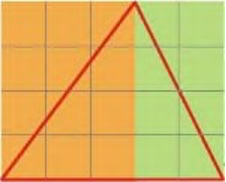
Answer:
There are two rectangles. The orange rectangle contains 12 complete squares and the green rectangle contains 8 complete squares.
Thus, area of an orange rectangle = 12 square cm
Area of green rectangle = 8 square cm Area of the orange portion of a triangle = (12 ÷ 2) square cm = 6 square cm
Area of green portion of the triangle = (8 ÷ 2) square cm = 4 square cm Area of red triangle = (6 + 4) square cm = 10 square cm
So, the area of red triangle is 10 square cm.
Page No 42:
Question 1: Suruchi drew two sides of a shape. She asked Asif to complete the shape with two more sides, so that its area is 10 square cm. He completed the shape like this.
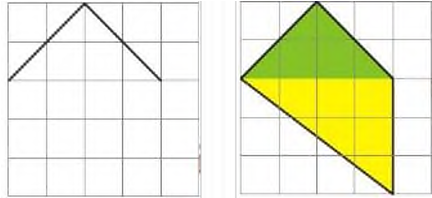
• Is the correct? Discuss.
• Explain how the green area is 4 square cm and the yellow area is 6 square cm.
Answer:
• Yes, Asif is correct.
• We will ignore a square that is less than half-filled, and we will count the square as 1, if it is more than half-filled.
In the green portion, we have two complete squares and four half squares. Area of one complete square = 1 square cm So, total area of green portion
= area of two complete squares + area of four half squares = (2 + 2) square
cm = 4 square cm
In the yellow portion, we have three complete squares, three squares that are more than half-filled, and two squares that are less than half-filled.
Now, area of 1 complete square = 1 square cm
Area of the yellow portion = area of three complete squares + area of three squares more than half-filled = (3 + 3) square cm = 6 square cm
Page No 43:
Question 1: Practice time
This is one of the sides of a shape. Complete the shape so that its area is 4 square cm.
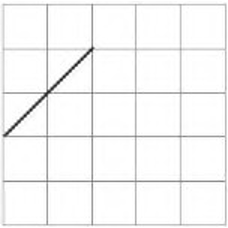
Answer:
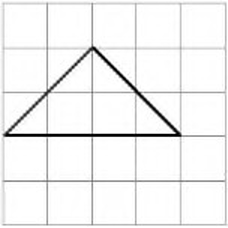
Question 2: Practice time
Two sides of a shape are drawn here. Complete the shape by drawing two more sides so that its area is less than 2 square cm.
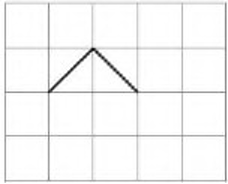
Answer:
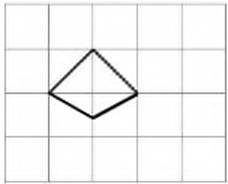
The given figure comprises of 2 half-filled squares and 2 squares that are less than half-filled. Thus, we will ignore the squares that are less than half filled.
So, area of the given figure = 1 square cm
Therefore, it clearly proves that the area of the figure i.e. 1 square cm is less than 2 square cm.
Page No 44:
Question 1: Here is a rectangle of area 20 square cm.
(a) Draw one straight line in this rectangle to divide it into two equal triangles. What is the area of each of the triangles?
(b) Draw one straight line in this rectangle to divide it into two equal rectangles. What is the area of each of the smaller rectangles?
(c) Draw two straight lines in this rectangle to divide it into one rectangle and two equal triangles.
• What is the area of the rectangle?
• What is the area of each of the triangles?
Answer:
(a) The given rectangle is divided into two equal triangles by drawing a line as shown below.

Area of rectangle = 20 square cm Area of each triangle = 12of area of rectangle = (20 ÷ 2) square cm = 10 square cm
(b) The given rectangle is divided into two equal rectangles by drawing a line as shown below.

Area of rectangle = 20 square cm Thus, area of each small rectangle = 12of area of rectangle = (20 ÷ 2) square cm = 10 square cm
(c) The given rectangle is divided into one rectangle and two equal triangles by drawing 2 lines as shown below.

We will consider a square as complete if it is more than half-filled, and will ignore a square if it is less than half-filled.
Thus, in the red shaded region, we have 2 completely filled squares and 2 squares that are more than half-filled. Thus, the area of red triangle = 4 square cm
Similarly, the area of green triangle = 4 square cm Now, the area of remaining portion i.e. the rectangle contains 12 completely filled squares.
• Thus, the area of rectangle = 12 square cm. • Area of each of the triangle is 4 square cm.
Disclaimer: The answer to part (c) of the question may vary from student to student. The answer provided here is for reference only.
Page No 45:
Question 1:
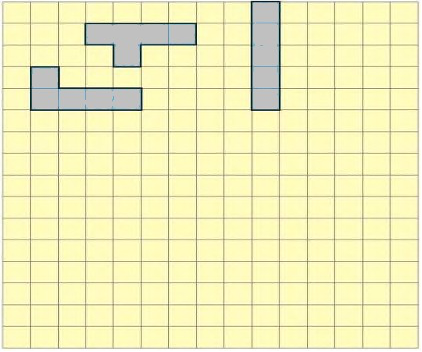
(a) How many different shapes can you draw? _____________
(b) Which shape has the longest perimeter? How much?______________cm
(c) Which shape has the shortest perimeter? How much? ______________cm
(d) What is the area of the shapes?______________square cm. That’s simple!
Answer:
(a) There are 12 different shapes that can be drawn using 5 squares.
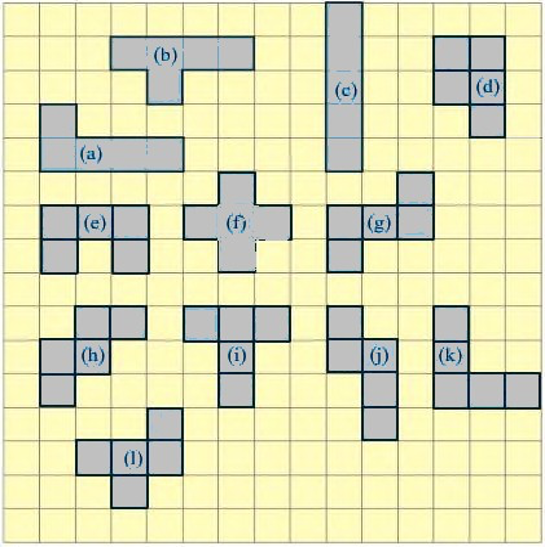
(b) Among all the 12 shapes, there is only one shape, figure (d) that has the smallest perimeter, but all the other shapes have same and longest perimeter.
Longest perimeter of each 11 shapes = (1 + 1 + 1 + 1 + 1 + 1 + 1 + 1 + 1
+ 1 + 1 + 1) cm = 12 cm
(c) The figure (d) has the smallest perimeter. Perimeter of figure (d) = (1
+ 1 + 1 + 1 + 1 + 1 + 1 + 1 + 1 + 1) cm = 10 cm
(d) We find that each of the 12 shapes covers 5 complete squares. Area of 1 complete square = 1 square cm Area of 5 complete squares = 1 × 5 square cm = 5 square cm
Area of each shape = Area of 5 complete squares = 5 square cm
Page No 49:
Question 1: Practice time Ziri tried to make some tiles. She started with a square of 2 cm side and made shapes like these.
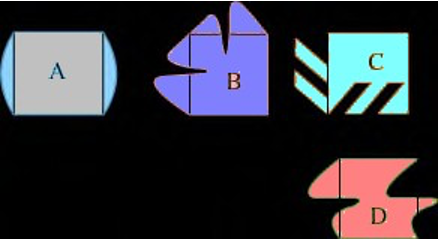
Look at these carefully and find out: • Which of these shapes will tile a floor (without any gaps)? Discuss. What is the area of these shapes? • Make designs in your copy by tiling those shapes.
Answer:
The shapes C and D will tile a floor without leaving any gaps. Area of each shape = 2 × 2 = 4 square cm
Design with shape C
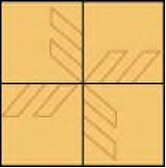
Design with shape D
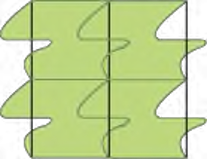
Disclaimer: The answer may vary from student to student. It is highly recommended that the students prepare the answer on their own.

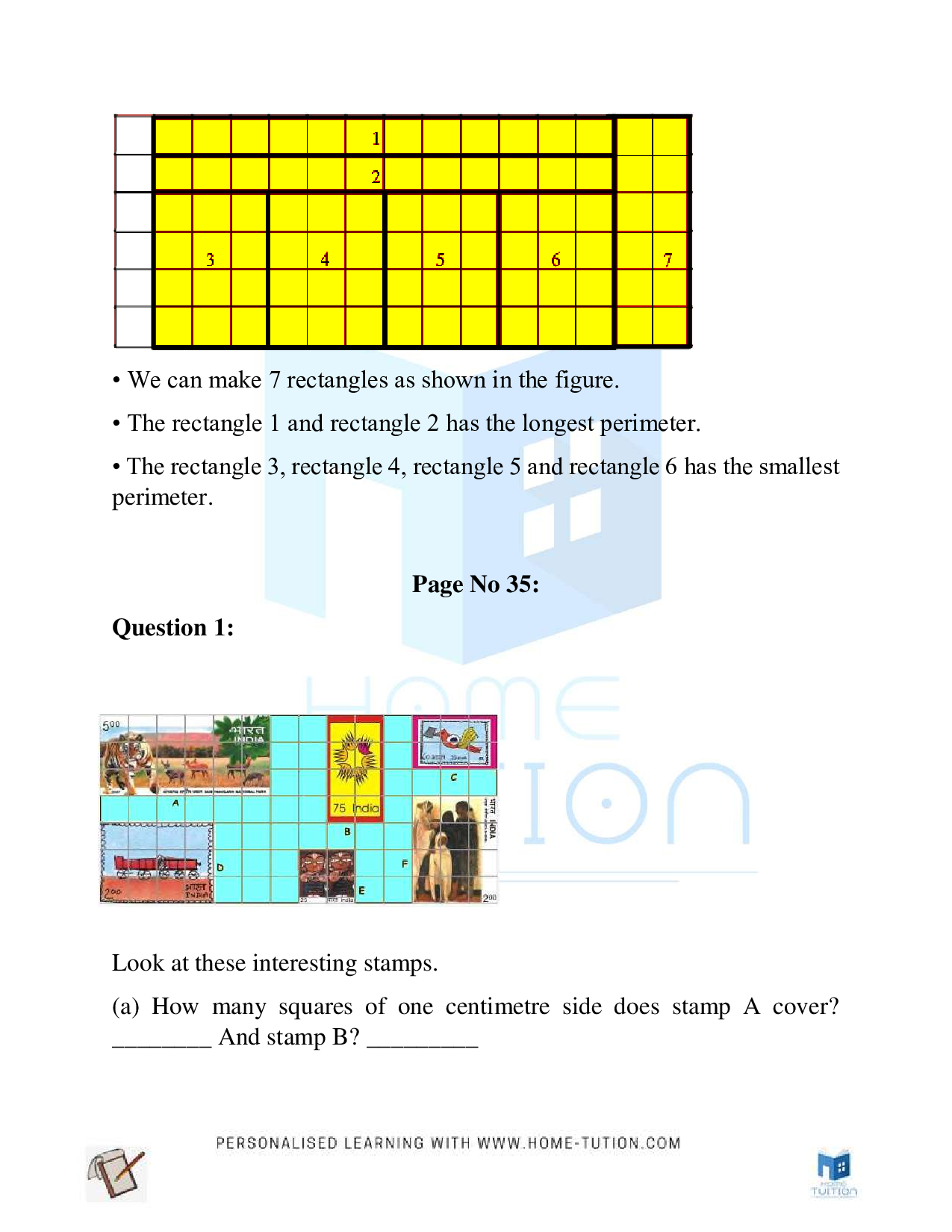

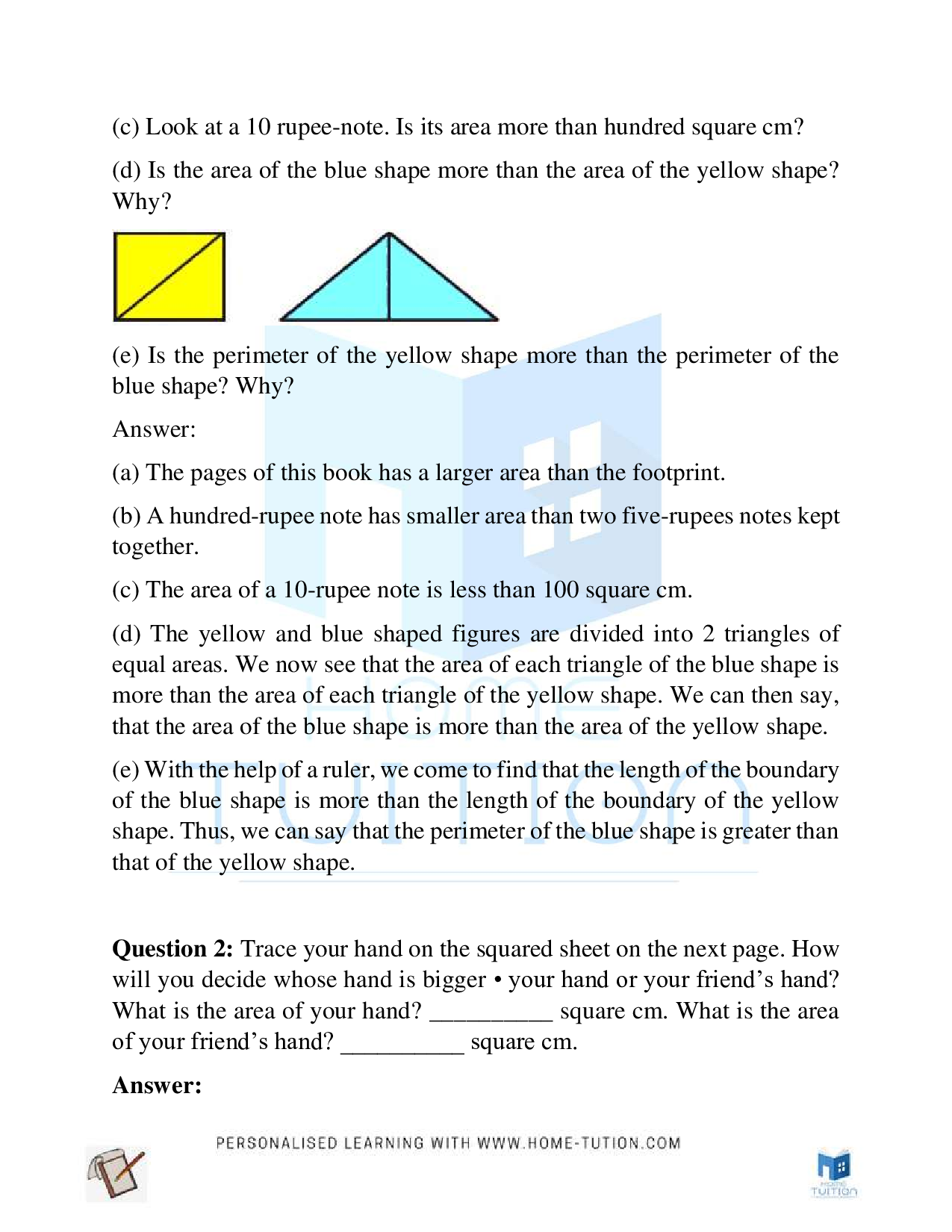
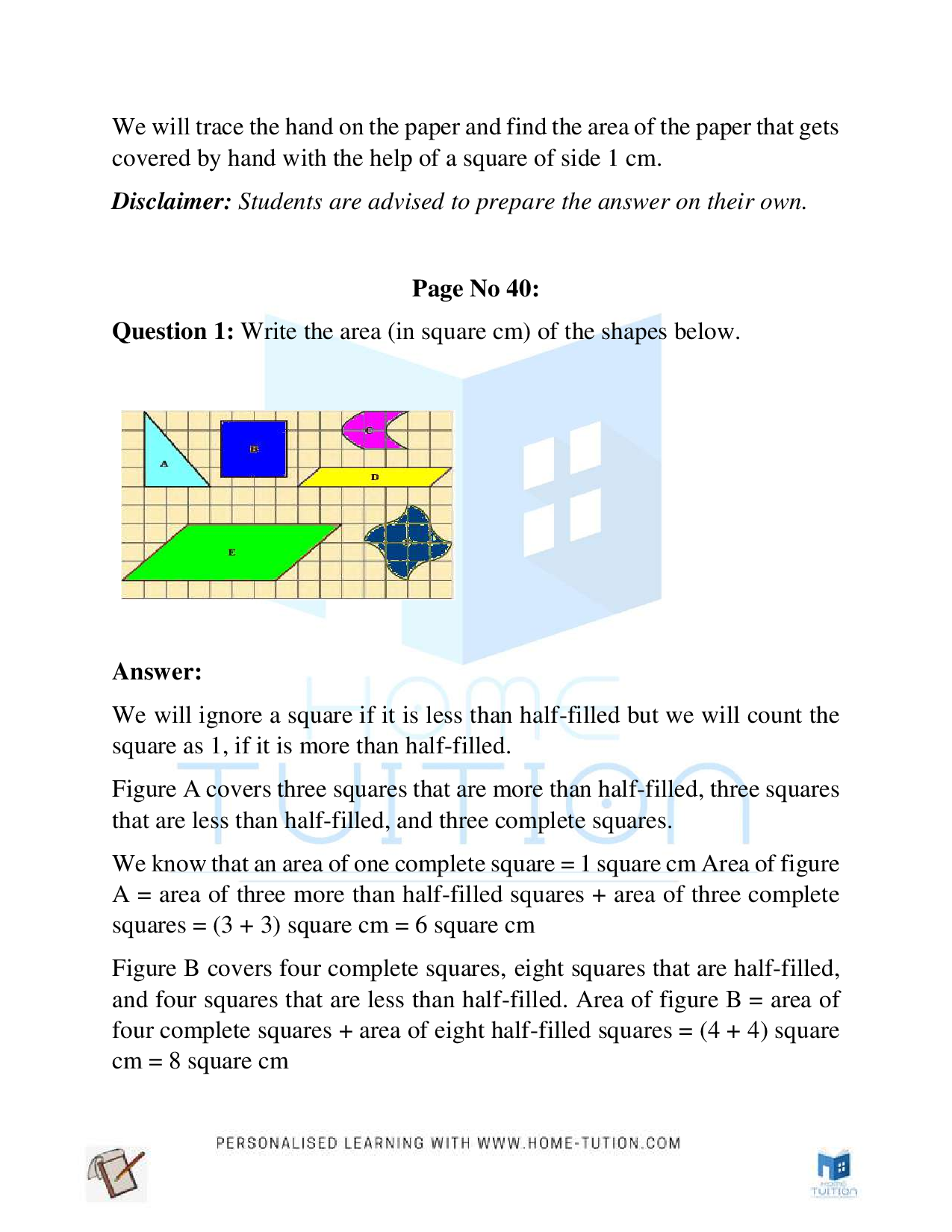
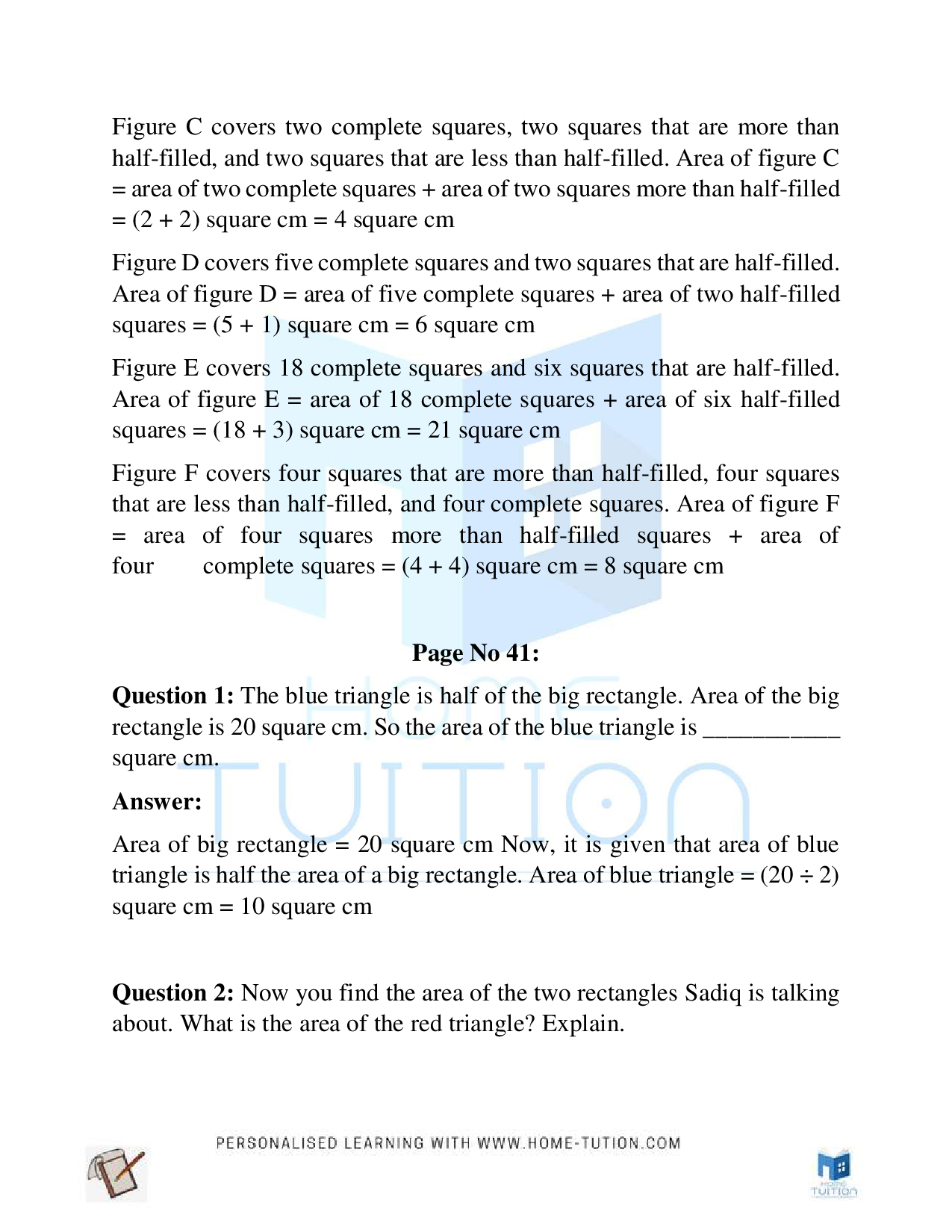
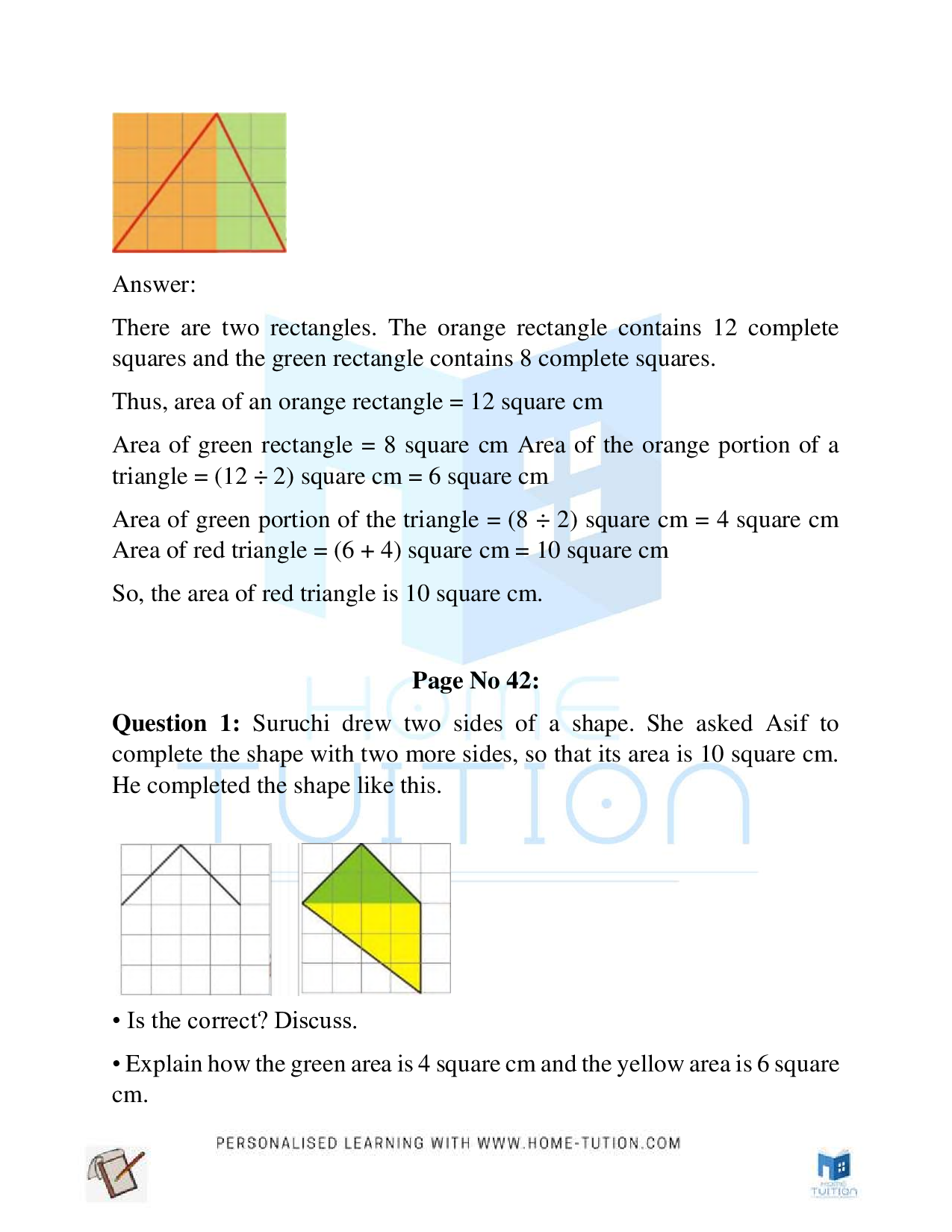

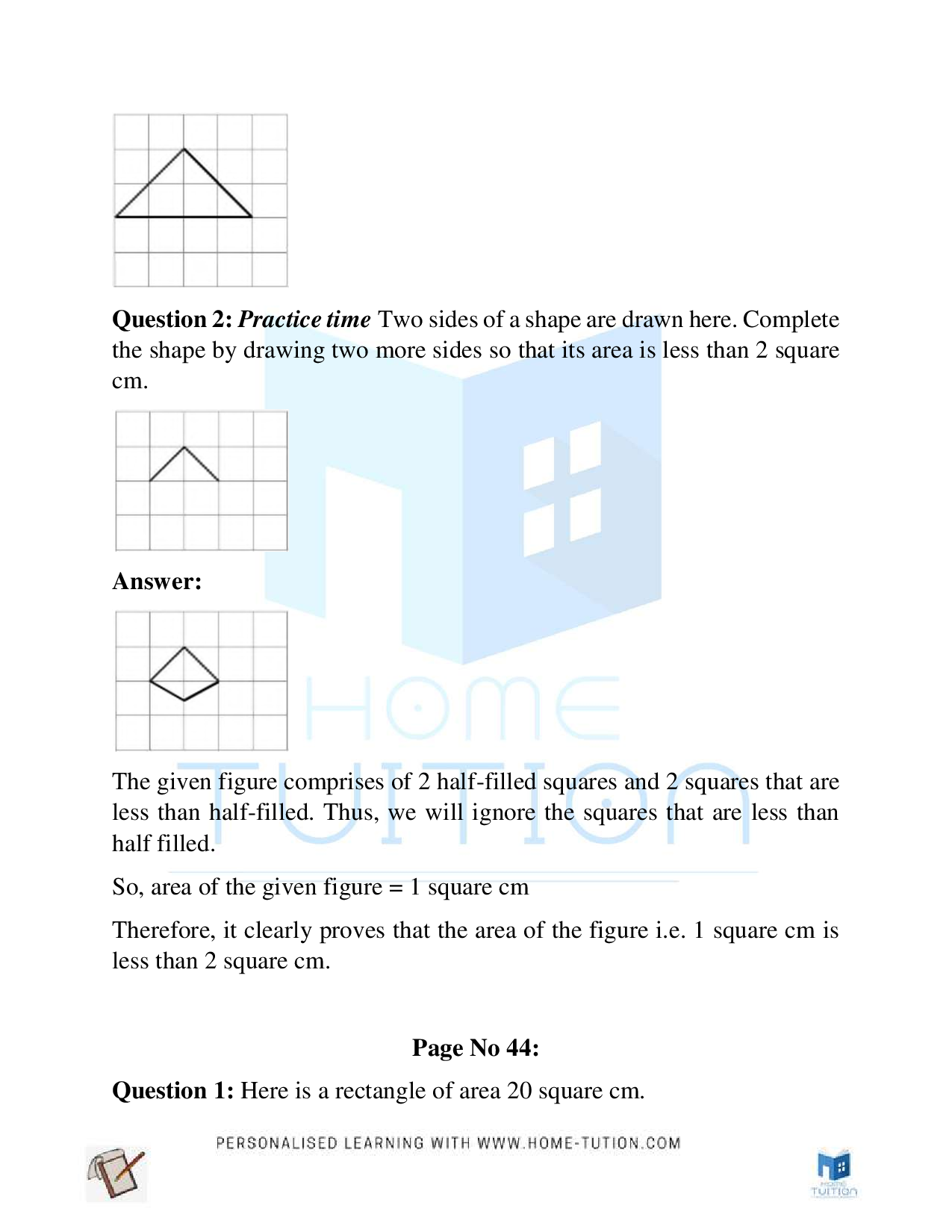
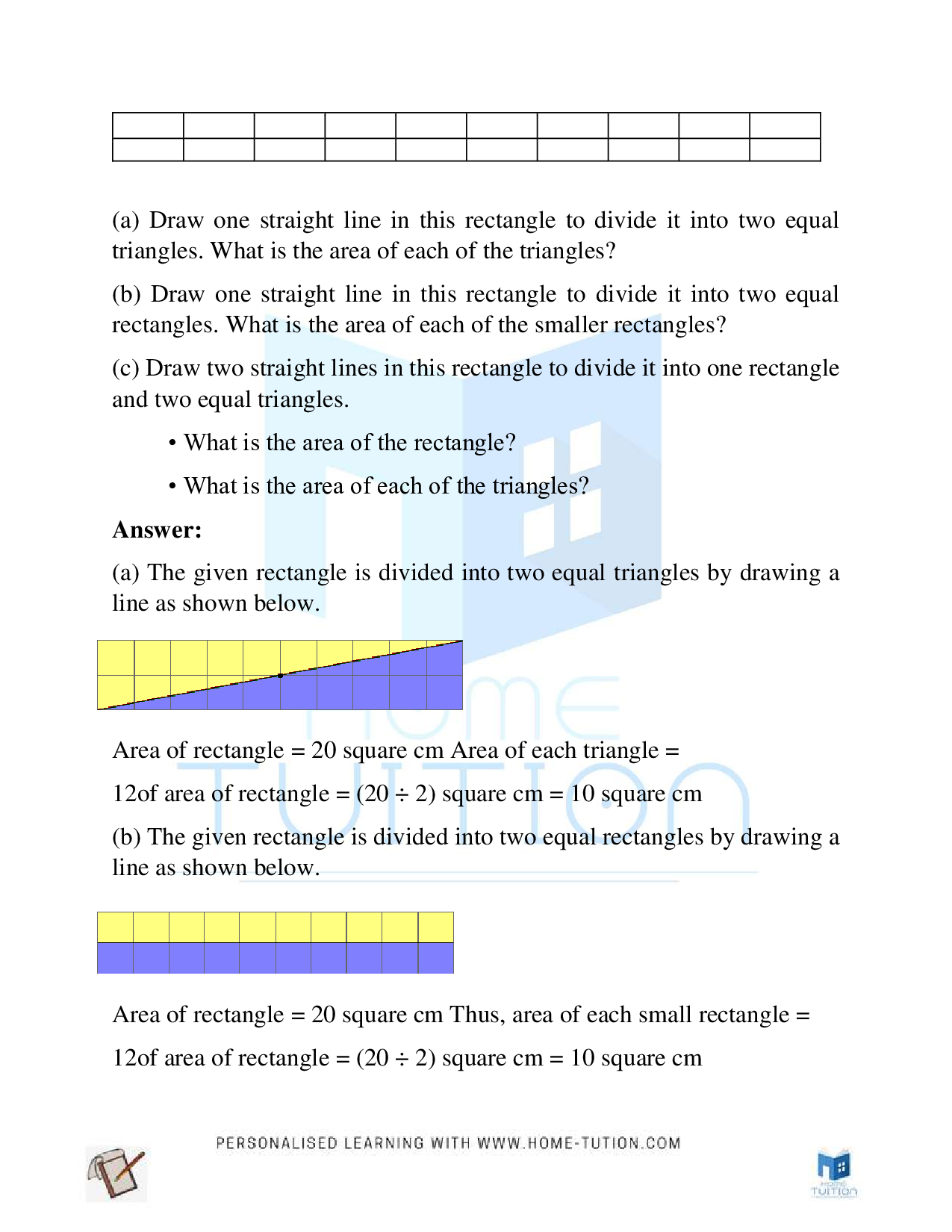
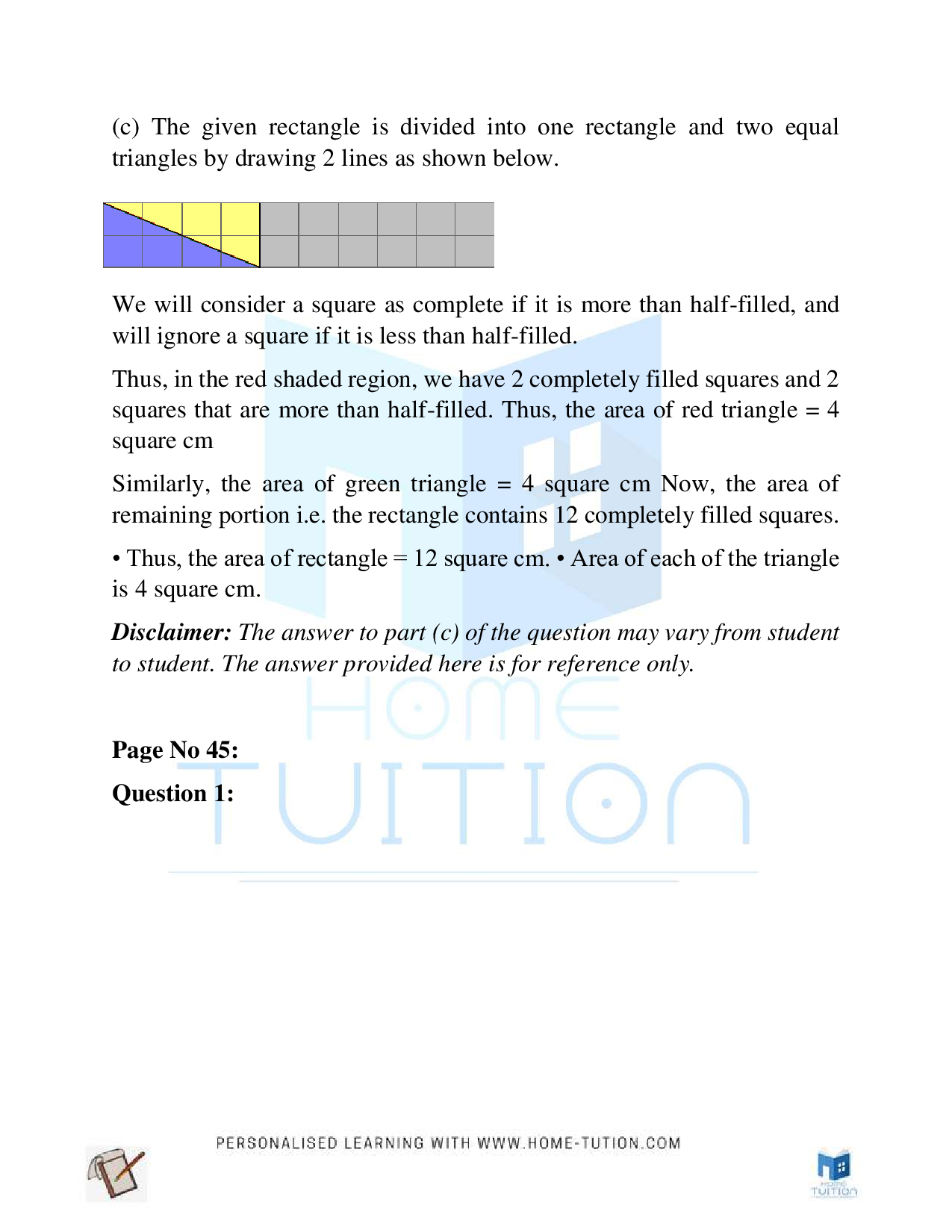

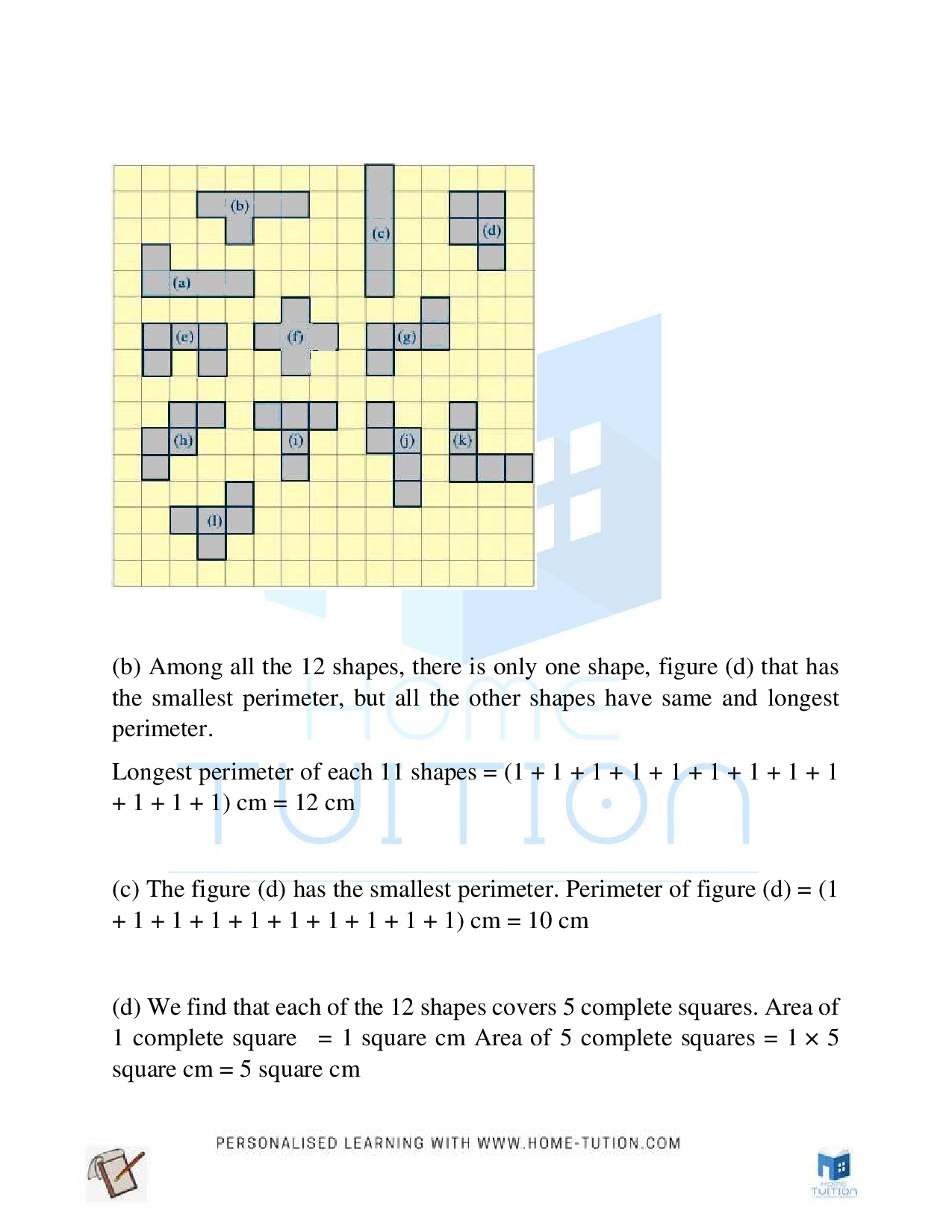
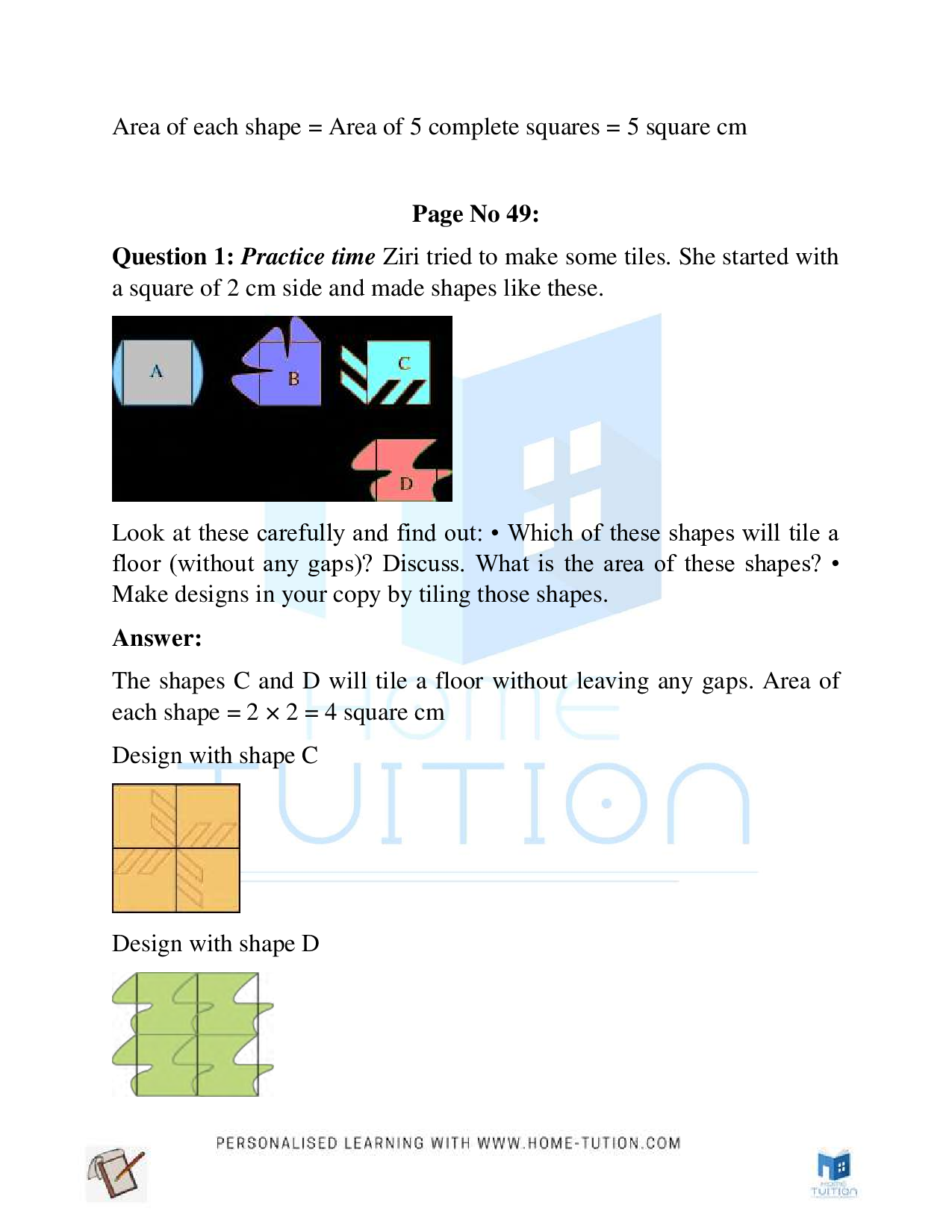

Related Links
- NCERT Class 5 Maths Chapter-1 The Fish Tale?
- NCERT Class 5 Maths Chapter 2 Shapes And Angles
- NCERT Class 5 Maths Chapter 3 How Many Squares?
- NCERT Class 5 Maths Chapter 4 Parts And Wholes
- NCERT Class 5 Maths Chapter 5 Does it Look The Same?
- NCERT Class 5 Maths Chapter 6 Be My Multiple, I’ll Be Your Factor
- NCERT Class 5 Maths Chapter 7 Can You See The Pattern?
- NCERT Class 5 Maths Chapter 8 Mapping Your Way
- NCERT Class 5 Maths Chapter 9 Boxes And Sketches
- NCERT Class 5 Maths Chapter 10 Tenths And Hundredths
- NCERT Class 5 Maths Chapter 11 Area and Its Boundary
- NCERT Class 5 Maths chapter- Chapter 12 Smart Charts
- NCERT Class 5 Maths Chapter 13 Ways To Multiply And Divide
- NCERT Class 5 Maths Chapter 14 How Big? How Heavy?